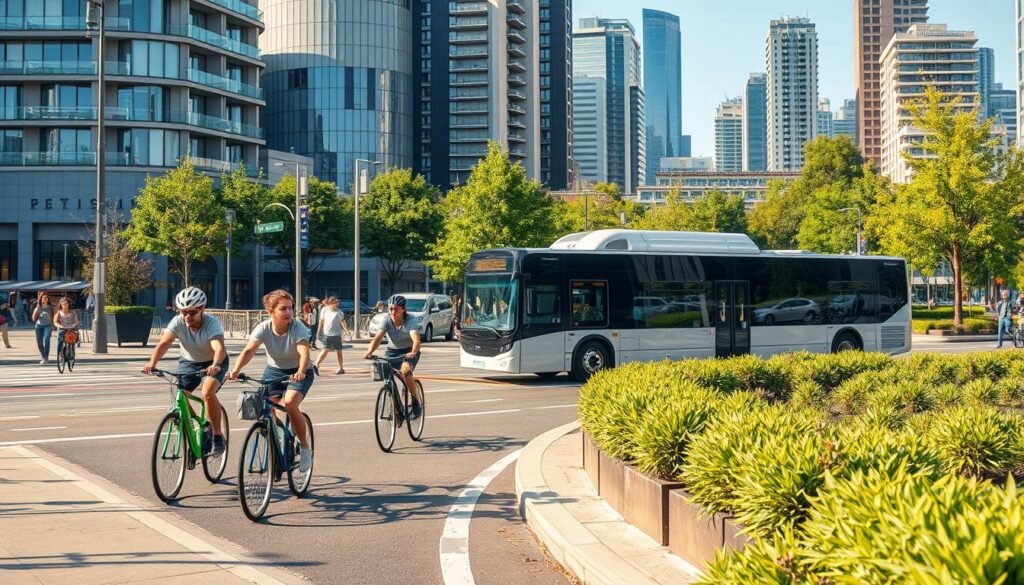Did you know small changes at home can slash your carbon footprint by over a ton each year? With high-income cities’ emissions set to double by 2050, individual actions now directly impact our collective future.
The latest IPCC reports reveal alarming gaps in climate progress. Governments aren’t moving fast enough—but households can. Simple swaps like LED bulbs cut 40kg of CO₂ annually, while smarter laundry habits preserve both clothes and the planet.
Every choice matters. From energy use to food waste, seven key areas offer immediate opportunities. Reducing meat consumption, optimizing transport, and rethinking purchases create ripple effects across supply chains.
Key Takeaways
- Household changes collectively combat climate change
- Global emissions must drop 66% by 2030 to avoid crisis
- Energy upgrades save 1 ton of carbon yearly per home
- Seven focus areas: energy, transport, food, fashion, waste, travel, finance
- 20 million face displacement yearly from consumption impacts
1. Adopt Energy-Efficient Home Upgrades
Modernizing household utilities isn’t just about savings—it’s a direct step toward reducing reliance on fossil fuels. Strategic upgrades can cut energy waste by 40% while shrinking your carbon footprint. Start with these high-impact changes:
Switch to LED Lighting
LED bulbs use 80–90% less energy than traditional incandescent lights. They last 12 times longer and emit minimal heat, reducing cooling costs. A single switch can save $75 annually per fixture.
Install Solar Panels
Solar PV systems generate clean power, saving 1 ton of CO₂ yearly per household. Pair them with heat pumps or battery storage for maximum efficiency. The ECO4 Scheme offers grants for qualifying upgrades like biomass boilers.
Use a Smart Thermostat
Devices like Google Nest learn your schedule and adjust temperatures automatically, saving 16.5% on gas use. Advanced models detect room occupancy and optimize heating patterns.
For deeper savings, consider window upgrades. Triple-glazed panes prevent 25% of heat loss while enhancing security and noise reduction. Hydrogen boilers and heat pumps (200–600% efficiency) are emerging alternatives to gas-dependent systems.
2. Reduce Meat and Dairy Consumption
What you put on your plate has a bigger climate impact than you might think. Agriculture generates 14.5% of global greenhouse gas emissions, with livestock contributing heavily through methane and nitrous oxide. These gases trap heat 25–300 times more effectively than CO₂.

Explore Plant-Based Alternatives
Swapping even a few meat dairy meals weekly cuts emissions significantly. Try blended burgers (mushroom + beef) or Meatless Mondays. Lentils, chickpeas, and tofu offer comparable protein with 90% lower carbon footprints than beef.
Local, seasonal produce also reduces food system strain. Imported goods travel ~1,500 miles on average, requiring refrigeration and fuel. A UK strawberry flown in off-season emits 10x the emissions of one grown locally in summer.
Support Local, Seasonal Produce
Seasonal eating aligns with nature’s calendar—think apples in fall or asparagus in spring. Community-supported agriculture (CSA) programs connect you directly with farmers, ensuring fresher food while slashing transport emissions.
Planning meals around seasonal availability minimizes waste. The UK discards 25 million tons of edible food yearly, equivalent to 36 million tons of CO₂. Simple steps like proper storage and creative leftovers use make a difference.
3. Minimize Food Waste
The average American household throws away $1,500 worth of edible food every year—enough to feed another family for months. With 40% of the U.S. food supply wasted, small changes in your kitchen can slash emissions and save money.
Plan Meals and Portions
Start with a weekly meal prep strategy. Store leftovers in clear containers at eye level to avoid forgotten meals. Use apps like Mealime to create shopping lists based on recipes, reducing impulse buys.
Turn common scraps into meals:
– Stale bread → croutons or bread pudding
– Vegetable peels → broth
– Overripe fruit → smoothies or baked goods
Compost Scraps for Soil Health
Composting diverts food waste from landfills, where it rots and releases methane. A simple backyard pile enriches soil with nutrients, cutting synthetic fertilizer use by 30%.
Compare methods:
– Bokashi: Ferments scraps in 2 weeks (ideal for apartments).
– Vermicompost: Worms break down waste faster.
– Traditional: Low-cost but slower (3–12 months).
Store herbs in damp towels or freeze chopped greens in oil cubes to extend freshness. Root cellars (or cool drawers) keep potatoes and onions crisp for weeks.
4. Choose Sustainable Transportation
Transportation accounts for nearly a third of U.S. greenhouse gas emissions, but smarter choices can shrink that impact. Road vehicles alone contribute 91% of transport-related pollution. Shifting habits here offers one of the fastest ways to reduce your carbon footprint.

Public Transit and Carpooling
Buses and trains emit 50% less CO₂ per mile than solo driving. Apps like Scoop or Waze Carpool match commuters heading the same way. Shared rides cut costs and emissions while reducing traffic congestion.
For shorter trips, walking or cycling eliminates tailpipe pollution entirely. Regular bike maintenance—like checking tire pressure and chain lubrication—ensures smooth, efficient rides.
Electric and Hybrid Vehicles
EVs produce 60% fewer lifetime emissions than gas cars, even accounting for battery production. Smart charging (off-peak hours) saves energy and lowers utility bills. The U.S. offers tax credits up to $7,500 for new EV purchases.
Hybrids bridge the gap with 40–60 MPG efficiency. Models like the Toyota Prius cut fuel use by half compared to standard sedans.
- CO₂/mile: Bikes (0g), EVs (50g), Gas cars (411g).
- Diesel phase-outs could reduce urban air pollution by 30%.
- European night trains (e.g., ÖBB Nightjet) expand low-carbon travel.
5. Cut Down on Single-Use Plastics
Plastic pollution chokes our oceans at an alarming rate—14 million tons enter marine ecosystems yearly. With 80% of marine debris being plastic, small daily swaps can curb this crisis. From grocery bags to personal care products, sustainable alternatives exist for every need.
Carry Reusable Bags and Bottles
Ditch disposable plastic bags for durable options. Cotton totes require 131 uses to outpace a single-use bag’s footprint, while recycled PET bags break even at just 11 uses. For hydration, stainless steel bottles last decades and resist odors better than glass.
Buy in Bulk to Reduce Packaging
Bulk stores like Zero Market (Colorado) or The Filling Station (NYC) slash packaging waste. A single bulk-bin trip can eliminate 10+ plastic containers weekly. Bring jars or cloth sacks for staples like grains, spices, and oils.
Microplastics from synthetic fabrics add 500,000 tons to oceans annually. Use Cora Ball or Guppyfriend washing bags to trap 35% of microfibers. For personal care, shampoo bars and bamboo toothbrushes avoid packaging entirely.
The UK’s plastic packaging tax charges £200/ton for under 30% recycled content, pushing brands toward sustainability. Join beach cleanups via Surfrider Foundation to protect sea life firsthand.
6. Revamp Your Laundry Routine
Your laundry habits could be sending millions of microplastics into waterways with every wash. Synthetic materials like polyester shed tiny fibers that bypass filtration systems. These account for 16% of ocean plastic pollution—equivalent to 50 billion plastic bottles yearly.

Wash Clothes Less Often
Many garments don’t need washing after single wears. Try airing jeans between uses or spot-cleaning stains with baking soda paste. Wool and silk naturally resist odors, while cotton can be refreshed with steam.
Front-loading machines use 40% less water than top-loaders. Wait for full loads—half cycles waste 1,500 gallons annually per household. Newer ENERGY STAR models cut energy use by 25% with sensors that adjust wash times.
Cold Water and Better Detergents
Switch to cold washes—they clean just as effectively while saving 90% of heating energy. Look for plant-based products with biodegradable formulas. Powder detergents create less packaging waste than pods.
Natural stain fighters work wonders:
– Lemon juice brightens whites
– Vinegar removes odors
– Salt sets fresh stains
Guppyfriend washing bags trap 86% of microfibers. Wool dryer balls replace toxic sheets and cut drying time by 25%. Always check care labels—wrong settings damage clothes and waste resources.
7. Ditch Fast Fashion
The fashion industry now ranks among the world’s top polluters, with emissions surpassing international flights and maritime shipping combined. Clothing production has quadrupled since 2000, generating 10% of global carbon emissions. Each year, 92 million tons of textiles become waste—equivalent to dumping 47 cruise ships’ worth of sulfur oxides.
Shop Secondhand or Swap Clothing
Thrifting reduces demand for new materials while saving items from landfills. Chains like Goodwill and Buffalo Exchange offer quality finds, while local consignment boutiques curate higher-end pieces. Clothing swaps with friends refresh wardrobes for free.
When buying vintage:
- Check seams and zippers for durability
- Authenticate designer labels with holograms or serial numbers
- Wash natural fibers (wool, silk) with pH-neutral cleaners
Invest in High-Quality, Sustainable Brands
Look for brands using organic cotton (uses 91% less water than conventional) or Tencel (biodegradable wood pulp fabric). B Corp-certified companies like Patagonia and Eileen Fisher meet strict environmental and labor standards.
Rental services extend garment lifespans:
- Rent the Runway: 20,000+ designer items
- Nuuly: Monthly subscriptions for 6 pieces
- Local libraries: Some now lend formalwear
Repair workshops teach mending skills—from darning socks to replacing buttons. A well-maintained garment lasts 5x longer, shrinking your clothing footprint dramatically.
8. Green Your Cleaning Supplies
The cleaning products under your sink may contain chemicals linked to respiratory issues and water contamination. Over 2 billion pounds of pesticides enter U.S. waterways annually from household use. Switching to safer alternatives protects both health and ecosystems.
Make DIY Natural Cleaners
Simple ingredients create effective cleaners without synthetic additives. Basic vinegar solutions disinfect surfaces, while baking soda scrubs remove stains. These products made at home cost 80% less than commercial brands.
Try these recipes:
– All-purpose spray: 1 cup vinegar + 1 cup water + 10 drops lemon oil
– Tub scrub: ½ cup baking soda + ¼ cup castile soap
– Glass cleaner: 2 cups water + ¼ cup rubbing alcohol
Choose Biodegradable Products
When buying cleaners, look for plant-based materials that break down safely. Microfiber cloths trap dust better than cotton rags, reducing chemical use. Enzyme cleaners with probiotics tackle pet stains naturally.
Trust these certifications:
– EPA Safer Choice: 700+ vetted products made without harsh chemicals
– EWG Verified: Meets strict toxicity standards
– Green Key: Audits supply chain impact
Refill stations at stores like Grove Collaborative cut packaging waste. Brands like Blueland offer concentrate tablets to mix with water at home.
9. Travel Responsibly
Every flight you take leaves a lasting mark on our planet‘s atmosphere—but smarter travel choices can lighten that impact. Aviation could consume one-sixth of humanity’s remaining carbon budget, making how we explore directly tied to climate change.
72% of travelers now prioritize sustainability according to Booking.com research. Small adjustments in planning and packing create measurable differences in your carbon footprint while maintaining adventure.
Limit Air Travel and Pack Light
Choosing trains over planes cuts emissions dramatically. A New York to Chicago trip emits 85% less CO₂ by rail. When flying is unavoidable, packing light reduces aircraft fuel use—every 10 lbs removed saves 1.4 gallons per 1,000 miles.
Verify carbon offset programs through Gold Standard or Verified Carbon Standard. These fund verified renewable energy projects that neutralize flight emissions. The “flight shame” movement has already reduced Swedish air travel by 8% through conscious consumer pressure.
Stay in Eco-Certified Accommodations
Hotels certified by the Global Sustainable Tourism Council meet strict criteria for reducing air pollution and waste. Look for LEED-certified buildings or properties using 100% renewable energy. Many now offer towel reuse programs and local organic dining options.
Voluntourism requires careful vetting—ask if projects align with local needs rather than tourist expectations. Follow Leave No Trace principles by staying on trails and avoiding wildlife disturbance. Simple actions like refusing daily linen changes conserve thousands of gallons of water annually.
10. Advocate for Change Beyond Home
Your financial decisions shape the world‘s energy future more than you realize—starting with where your retirement funds are invested. UK pensions alone funnel £128 billion into fossil fuels, driving climate change equivalent to 19 tons of CO₂ per person annually. Redirecting these funds can accelerate the transition to renewable power.

Switch to an Ethical Pension Fund
Providers like Nest Ethical and Legal & General Future World exclude fossil fuels and prioritize green bonds. Shareholder advocacy—attending annual meetings or voting on resolutions—pressures companies to reduce their environmental impact.
Compare portfolios using tools like Make My Money Matter. Funds with >50% renewables exposure can cut your financial footprint by 60%.
Support Policies for Renewable Energy
Local demand drives progress. Community Choice Aggregation (CCA) programs let municipalities purchase clean energy collectively. California’s Marin Clean Energy now serves 1 million customers with 60% renewable sources.
Track ballot initiatives via Vote Solar. The ECO4 Scheme offers boiler grants for low-income households, proving policy change starts at the grassroots.
Conclusion
Small daily actions create a ripple effect that shapes our planet’s future. Focusing on energy, food, transport, and other key areas adds up to meaningful change.
Together, these steps reduce waste and slow climate change. Share what works with friends or try a carbon footprint calculator to track progress.
Renewable tech and circular economies are rising fast. By acting now, we safeguard resources for future generations—proving every effort counts.
FAQ
How can I make my home more energy-efficient?
Switching to LED bulbs, installing solar panels, and using a smart thermostat can cut energy use. These changes lower bills and reduce emissions.
What are easy ways to eat more sustainably?
Try plant-based meals and buy local, seasonal produce. Reducing meat and dairy lowers your carbon footprint and supports farmers.
How do I minimize food waste at home?
Plan meals ahead, store food properly, and compost scraps. This saves money and enriches soil instead of landfills.
What’s the best way to cut plastic waste?
Carry reusable bags, bottles, and containers. Buying in bulk reduces packaging and keeps single-use plastics out of oceans.
Can laundry habits really impact the planet?
Yes! Washing clothes less often, using cold water, and eco-detergents save energy and prevent microfiber pollution.
How can I dress more sustainably?
Shop secondhand, swap clothes with friends, or choose durable brands like Patagonia. Fast fashion harms the environment.
Are natural cleaners effective?
DIY mixes with vinegar or baking soda work well. Brands like Seventh Generation offer biodegradable options for tougher jobs.
What makes travel eco-friendly?
Take trains instead of planes, pack light, and stay at Green Key-certified hotels. Fewer flights mean lower emissions.
How can I advocate for bigger climate action?
Support renewable energy policies and switch pension funds to ethical investments. Collective change drives progress.



